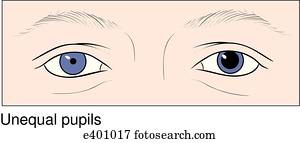

Tonsillar herniation: A mass in the infratentorial area of the brain forces the cerebellar tonsils, small structures at the base of the brain, through the foramen magnum, an opening in the skull.Central: Both temporal lobes shift through an opening in the tentorium, called the tentorial notch.To be clear, pupil size refers to the diameter of the black circular aperture in the center of the eye. Uneven pupil size, or anisocoria, may be a normal variation in a person’s eyes or may indicate an underlying problem. It can range from around two to eight millimeters. Transtentorial or uncal: A mass may squeeze the medial temporal lobe under and across a membrane called the tentorium. Pupillary Disorders Including Anisocoria Eyes In the mirror, the pupil of the eye appears as a black circle in the middle of the iris (the colored part of the eye).In physiologic anisocoria, the difference in pupil size does not change under bright or dim light. This is the most common type of brain herniation. Typically, with physiologic anisocoria, the difference in pupil size between the two eyes does not exceed one millimeter. Subfalcine: The cingulate gyrus, an arch-shaped section of the brain, pushes against the falx cerebri, a crescent-shaped section between the left and right sides of the brain.There are five different types of brain herniation, depending on the affected part of the brain:
#Unequal pupil size in infants how to
It may occur due to a head injury, brain tumor, or stroke. Paediatric information for Anisocoria (unequal pupils) The following information provides a guide for GPs on how to manage or make a referral for presentation of Anisocoria (unequal pupils) in children. Measurement of pupil size with the video screen of an infrared autorefractor. The varied causes have implications ranging from life threatening to completely benign, and a clinically guided history and examination is the first step in establishing a diagnosis. Coma or brain death: Severe brain damage may cause a change in the size and reactivity of the pupils.Share on Pinterest Johnny Greig/Getty Imagesīrain herniation happens when brain tissue, cerebrospinal fluid (CSF), and blood move from their usual position inside the skull and create increased pressure within it. Anisocoria, or unequal pupil sizes, is a common condition.Surgery: Eye surgery may result in alterations in pupil size, which can be permanent.


Inflammatory conditions, such as MS and sarcoidosis, also can do this. Inflammation: An infection affecting the eye or the cranial nerves can cause anisocoria.Cranial nerve damage: This can occur due to a stroke (a blockage of blood flow or bleeding in the brain), brain aneurysm (defect in a blood vessel), or a brain tumor. Having a seizure temporarily changes pupil size for some persons.Also, for unknown reasons, pupils may temporarily differ in size. If other family members also have similar pupils, then the pupil size difference could be genetic and is nothing to worry about. Multiple sclerosis (MS): MS is a chronic neurological disorder that causes symptoms affecting vision, movement, sensation, and more. Babies born with different sized pupils may not have any underlying disorder.


 0 kommentar(er)
0 kommentar(er)
